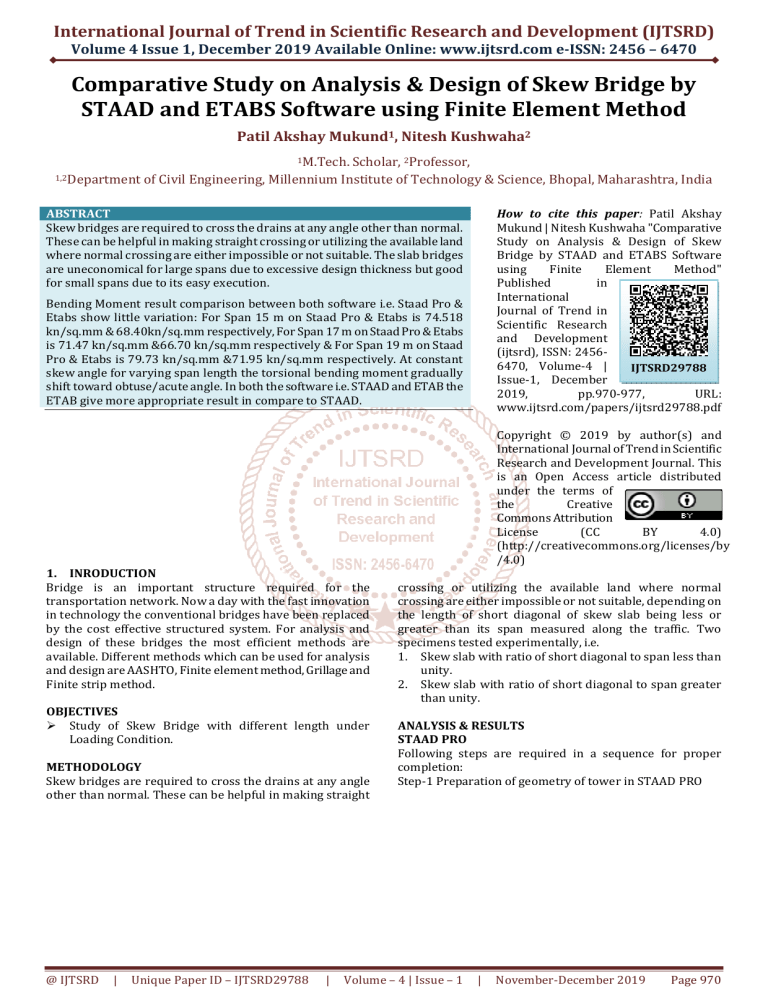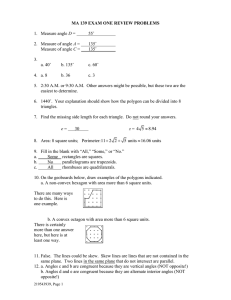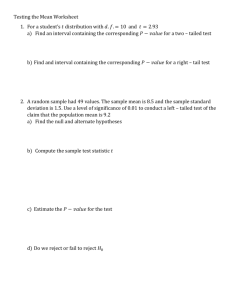
International Journal of Trend in Scientific Research and Development (IJTSRD)
Volume 4 Issue 1, December 2019 Available Online: www.ijtsrd.com e-ISSN: 2456 – 6470
Comparative Study on Analysis & Design of Skew Bridge by
STAAD and ETABS Software using Finite Element Method
Patil Akshay Mukund1, Nitesh Kushwaha2
1M.Tech.
Scholar, 2Professor,
1,2Department of Civil Engineering, Millennium Institute of Technology & Science, Bhopal, Maharashtra, India
How to cite this paper: Patil Akshay
Mukund | Nitesh Kushwaha "Comparative
Study on Analysis & Design of Skew
Bridge by STAAD and ETABS Software
using
Finite
Element
Method"
Published
in
International
Journal of Trend in
Scientific Research
and Development
(ijtsrd), ISSN: 24566470, Volume-4 |
IJTSRD29788
Issue-1, December
2019,
pp.970-977,
URL:
www.ijtsrd.com/papers/ijtsrd29788.pdf
ABSTRACT
Skew bridges are required to cross the drains at any angle other than normal.
These can be helpful in making straight crossing or utilizing the available land
where normal crossing are either impossible or not suitable. The slab bridges
are uneconomical for large spans due to excessive design thickness but good
for small spans due to its easy execution.
Bending Moment result comparison between both software i.e. Staad Pro &
Etabs show little variation: For Span 15 m on Staad Pro & Etabs is 74.518
kn/sq.mm & 68.40kn/sq.mm respectively, For Span 17 m on Staad Pro & Etabs
is 71.47 kn/sq.mm &66.70 kn/sq.mm respectively & For Span 19 m on Staad
Pro & Etabs is 79.73 kn/sq.mm &71.95 kn/sq.mm respectively. At constant
skew angle for varying span length the torsional bending moment gradually
shift toward obtuse/acute angle. In both the software i.e. STAAD and ETAB the
ETAB give more appropriate result in compare to STAAD.
Copyright © 2019 by author(s) and
International Journal of Trend in Scientific
Research and Development Journal. This
is an Open Access article distributed
under the terms of
the
Creative
Commons Attribution
License
(CC
BY
4.0)
(http://creativecommons.org/licenses/by
/4.0)
1. INRODUCTION
Bridge is an important structure required for the
transportation network. Now a day with the fast innovation
in technology the conventional bridges have been replaced
by the cost effective structured system. For analysis and
design of these bridges the most efficient methods are
available. Different methods which can be used for analysis
and design are AASHTO, Finite element method, Grillage and
Finite strip method.
OBJECTIVES
Study of Skew Bridge with different length under
Loading Condition.
METHODOLOGY
Skew bridges are required to cross the drains at any angle
other than normal. These can be helpful in making straight
@ IJTSRD
|
Unique Paper ID – IJTSRD29788
|
crossing or utilizing the available land where normal
crossing are either impossible or not suitable, depending on
the length of short diagonal of skew slab being less or
greater than its span measured along the traffic. Two
specimens tested experimentally, i.e.
1. Skew slab with ratio of short diagonal to span less than
unity.
2. Skew slab with ratio of short diagonal to span greater
than unity.
ANALYSIS & RESULTS
STAAD PRO
Following steps are required in a sequence for proper
completion:
Step-1 Preparation of geometry of tower in STAAD PRO
Volume – 4 | Issue – 1
|
November-December 2019
Page 970
International Journal of Trend in Scientific Research and Development (IJTSRD) @ www.ijtsrd.com eISSN: 2456-6470
Fig 4.1 Plan view of slab with 15m span length at 15◦ skew angle
Fig 4.2 3D view of slab with 15m span length at 15◦ skew angle
Fig 4.3 Plan view of slab with 17m span length at 15◦ skew angle
@ IJTSRD
|
Unique Paper ID – IJTSRD29788
|
Volume – 4 | Issue – 1
|
November-December 2019
Page 971
International Journal of Trend in Scientific Research and Development (IJTSRD) @ www.ijtsrd.com eISSN: 2456-6470
Fig 4.4 3D view of slab with 17m span length at 15◦ skew Angle
Fig 4.5 Plan view of slab with 19m span length at 15◦ skew angle
Fig 4.6 3D view of slab with 19m span length at 15◦ skew angle
Step-2 Assigning of support conditions.
@ IJTSRD
|
Unique Paper ID – IJTSRD29788
|
Volume – 4 | Issue – 1
|
November-December 2019
Page 972
International Journal of Trend in Scientific Research and Development (IJTSRD) @ www.ijtsrd.com eISSN: 2456-6470
Fig 4.7 Support on slab with 15m span length at 15◦ skew angle
Fig 4.8 Support on slab with 17m span length at 15◦ skew angle
Fig 4.9 Support on slab with 19m span length at 15◦ skew angle
@ IJTSRD
|
Unique Paper ID – IJTSRD29788
|
Volume – 4 | Issue – 1
|
November-December 2019
Page 973
International Journal of Trend in Scientific Research and Development (IJTSRD) @ www.ijtsrd.com eISSN: 2456-6470
Step-3 Assigning vehicle load as per specification.
Fig 4.10 Load on slab with 15m span length at 15◦ skew angle
Fig 4.11 Load on slab with 17m span length at 15◦ skew angle
Fig 4.12 Load on slab with 19m span length at 15◦ skew angle
@ IJTSRD
|
Unique Paper ID – IJTSRD29788
|
Volume – 4 | Issue – 1
|
November-December 2019
Page 974
International Journal of Trend in Scientific Research and Development (IJTSRD) @ www.ijtsrd.com eISSN: 2456-6470
Step-4 Analysis
M Y
( lo c a l)
k N m / m
< = 0 . 3 6 2
5 . 6 8
1 1
1 6 . 3
2 1 . 6
2 7
3 2 . 3
3 7 . 6
4 2 . 9
4 8 . 2
5 3 . 6
5 8 . 9
6 4 . 2
6 9 . 5
7 4 . 8
8 0 . 2
> =
8 5 . 5
Y X
Load 2
Z
Fig 4.13 Analysis of slab with 15m span length at 15◦ skew angle
M Y
( lo c a l)
k N m / m
< =
0 . 3 6 2
5 . 6 8
1 1
1 6 . 3
2 1 . 6
2 7
3 2 . 3
3 7 . 6
4 2 . 9
4 8 . 2
5 3 . 6
5 8 . 9
6 4 . 2
6 9 . 5
7 4 . 8
8 0 . 2
> =
8 5 . 5
Y X
Load 2
Z
Fig 4.14 Analysis of slab with 17m span length at 15◦ skew angle
M Y
( lo c a l)
k N m / m
< =
0 . 0 4 0
5 . 1 1
1 0 . 2
1 5 . 2
2 0 . 3
2 5 . 4
3 0 . 5
3 5 . 5
4 0 . 6
4 5 . 7
5 0 . 7
5 5 . 8
6 0 . 9
6 5 . 9
7 1
7 6 . 1
> =
Y
8 1 . 1
X
Load 2
Z
Fig 4.15 Analysis of slab with 19m span length at 15◦ skew angle
@ IJTSRD
|
Unique Paper ID – IJTSRD29788
|
Volume – 4 | Issue – 1
|
November-December 2019
Page 975
International Journal of Trend in Scientific Research and Development (IJTSRD) @ www.ijtsrd.com eISSN: 2456-6470
GRAPHICAL REPRESENTATION MOMENT ON BRIDGE BY BOTH SOFTWARE
GRAPH OF MAXIMUM DISPLACEMENT
Graph 5.1 Maximum Displacement Graph
GRAPH OF MAXIMUM STRESS
Graph 5.2 Maximum Stress Qx Graph
Graph 5.3 Maximum Stress Qy Graph
@ IJTSRD
|
Unique Paper ID – IJTSRD29788
|
Volume – 4 | Issue – 1
|
November-December 2019
Page 976
International Journal of Trend in Scientific Research and Development (IJTSRD) @ www.ijtsrd.com eISSN: 2456-6470
CONCLUSION
The load capacity of the tilting slab increases as the tilting
angle increases. Up to the angle of inclination 15° the
behavior of the slanted slab is almost similar to the
rectangular slab.
1.
Considerable torsion of deck slab.
2.
Displacement result comparison between both software i.e.
Staad Pro & Etabs show very nominal variation:
a.
b.
c.
3.
Bending Moment result comparison between both software i.e.
Staad Pro & Etabs show little variation:
a.
b.
c.
4.
For Span 15 m on Staad Pro & Etabs is 17.016mm &
17.047mm respectively.
For Span 17 m on Staad Pro & Etabs is 14.641mm &
14.204mm respectively.
For Span 19 m on Staad Pro & Etabs is 13.638mm &
13.218mm respectively.
For Span 15 m on Staad Pro & Etabs is 74.518 kn/sq.mm &
68.40 kn/sq.mm respectively.
For Span 17 m on Staad Pro & Etabs is 71.47 kn/sq.mm &
66.70 kn/sq.mm respectively.
For Span 19 m on Staad Pro & Etabs is 79.73 kn/sq.mm &
71.95 kn/sq.mm respectively.
At constant skew angle for varying span length the torsional
bending moment gradually shift toward obtuse/acute angle.
REFERENCES
[1] Ajay D. Shahu, S. V. Joshi (2016)“Analysis and
behaviour of skew bridges with different skew angle”
Volume 3 IJCESR.
[2] Al.l Mubaydeen, H.Y.H 2005 Stress Distribution at the
Corner of Continuous Skew Bridges, M.Sc.l Thesis,
University of Jordan, Amman, Jordan.
[3] Alasa'd Intesar, 1977.l Stress Distribution at the
Corners of Skew Bridges, M.l Sc.l Thesis, University of
Jordan, Amman, Jordan.l PP.l (1-136).
[4]
Al-Foqaha'a, A.l 1994.l Study of Recent Loading
Adopted for Bridge Design in Jordan, M.l Sc.l Thesis,
University of Jordan, Amman, Jordan.
[5] Alfred G. Bishara, Maria Chuan Liu And Nasser
[6] Australian Bridge Design code, AUSTROADS, 1992
[7] Bridge Design using the STAAD. Pro/Beava”, IEG
Group, Bentley Systems, Bentley Systems Inc., March
2008.
[8] Cement & Concrete Association, Construction Industry
Research
and
Information
Association,
Recommendations on the use of Grillage Analysis for
Slab and Pseudo-Slab Bridge Decks, London,
SW1WOAQ, 1973.
[9] Computer & Structures, Inc., SAP90 (Finite Element
Analysis Users Manual), Berkeley, California.l 94704
USA, 1989.l PP.300.
[10] Corley, W.l G.l Huang, T.l and Jurkovich, W.J.l 1973.l
Preliminary Design and Proportioning of Reinforced
Concrete Bridge Structures.l ACI Journal.l 70 (5): 328336.
@ IJTSRD
|
Unique Paper ID – IJTSRD29788
|
Volume – 4 | Issue – 1
|
November-December 2019
Page 977



